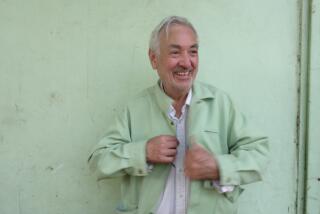Architect accepts UCLA position
- Share via
Architect Hitoshi Abe, who has built little outside his native Japan but has strong ties to Southern California, has accepted an offer to become chair of the architecture and urban design department at UCLA.
The appointment, which requires approval by the university and chancellor, is expected to become effective after the beginning of the year, with Abe’s arrival to follow in the spring term.
Abe, who teaches at Tohoku University and runs the 10-person firm Atelier Hitoshi Abe in Sendai, in the country’s northeast, said he hoped to “create a network toward the East” for the university.
“UCLA is on the West Coast, but it’s still looking toward the East Coast and Europe,” he said from Sendai. “But there’s a lot of interesting things happening in Asia and in South America, on the Pacific Rim. And I’m very interested in applications of new technology, like robots and information technology. This is happening in an extreme way in Japan, and I’d like to bring it to UCLA.”
Abe was born in 1962, earned a master’s degree at the Southern California Institute of Architecture in 1989 and worked until 1992 at the L.A. office of the Viennese firm Coop Himmelb(l)au. He returned to Japan that year, started his own firm and began work on the 50,000-capacity Miyagi Stadium near Sendai. In ‘93, he earned a doctorate from Tohoku University, from which he also holds a master’s in architecture.
In addition to homes and public housing, his firm has designed Shirasagi Bridge in Shiroishi, the Michinoku Folklore Museum in Kamakura and the Reihoku Community Hall.
“I accepted,” he says, “whatever we could get.”
Architect Neil Denari, who teaches at UCLA and was a professor of Abe’s at SCI-Arc, was in Japan last May and saw some of Abe’s recent projects.
“His work is not only diverse in terms of projects, it’s also diverse-looking,” Denari says. “You wouldn’t attribute all the work to a single figure.
“He’s not obsessed with having an inimitable architectural vocabulary. Each project is quite an open discourse, guided by, say, material experimentation, or guided dramatically by a site. He sees architecture as an open dialogue that’s never predictable.”
As a student, Denari says, “Hitoshi’s work was always incredibly radical, just pushing the limits.”
In the late ‘80s, he says, professors such as Thom Mayne, Michael Rotondi and Wolf Prix, who later became Abe’s boss at Coop Himmelb(l)au, had created a chance-taking, theory-rich intellectual atmosphere at SCI-Arc. “Hitoshi approached it with abandon, and also humility. His craft and skill and talent were amazingly obvious.”
If appointed, Abe will replace Sylvia Lavin, whose term ended this summer after 10 years as chair. Lavin was credited with raising the visibility and intellectual rigor of the program, but also alienated some faculty and students, many of whom left the department because of complaints about her managerial style. She will remain on the department faculty. Diane Favro is the current acting chair.
Denari said although UCLA could have chosen an architect with a bolder stylistic stamp, “Hitoshi’s openness to dialogue and experimentation doesn’t make him a bland, democratic figure. And he’s not provincial at all: Even though he hasn’t built much outside of Japan, he fits very well into the global network the university has cultivated.”
Among his current projects, Abe lists research into cities and communities that are losing population, which is widespread in parts of Japan, and well as studying the ways information technology is altering the design of office spaces. His firm also is designing a Vietnamese resort.
“I’m interested in how you can apply design theory to actual practice, and into the vocabulary of construction,” Abe says. “I think it’s one of the reasons I was selected by UCLA.”
Abe says he’s looking forward to returning to California. “I enjoyed especially feeling like I was in a very creative environment,” he says of his almost six years in Los Angeles. “The weather is great, and there’s a sensation of freedom.”
He added: “I don’t like traffic jams, but that was very minor.”
More to Read
The biggest entertainment stories
Get our big stories about Hollywood, film, television, music, arts, culture and more right in your inbox as soon as they publish.
You may occasionally receive promotional content from the Los Angeles Times.










